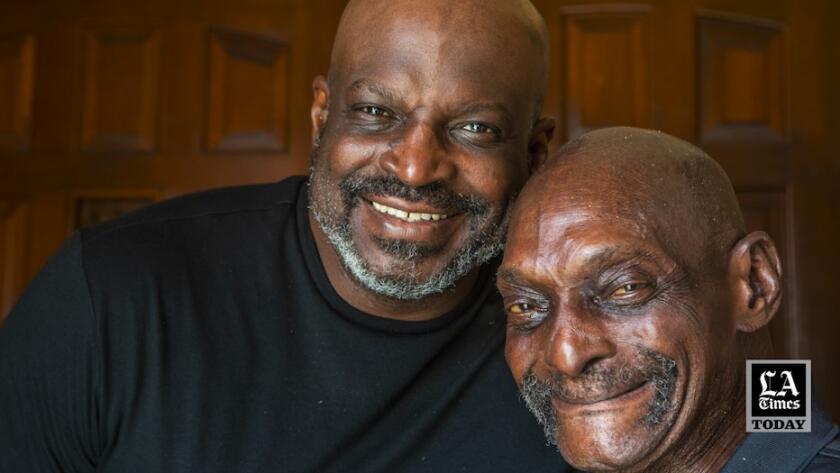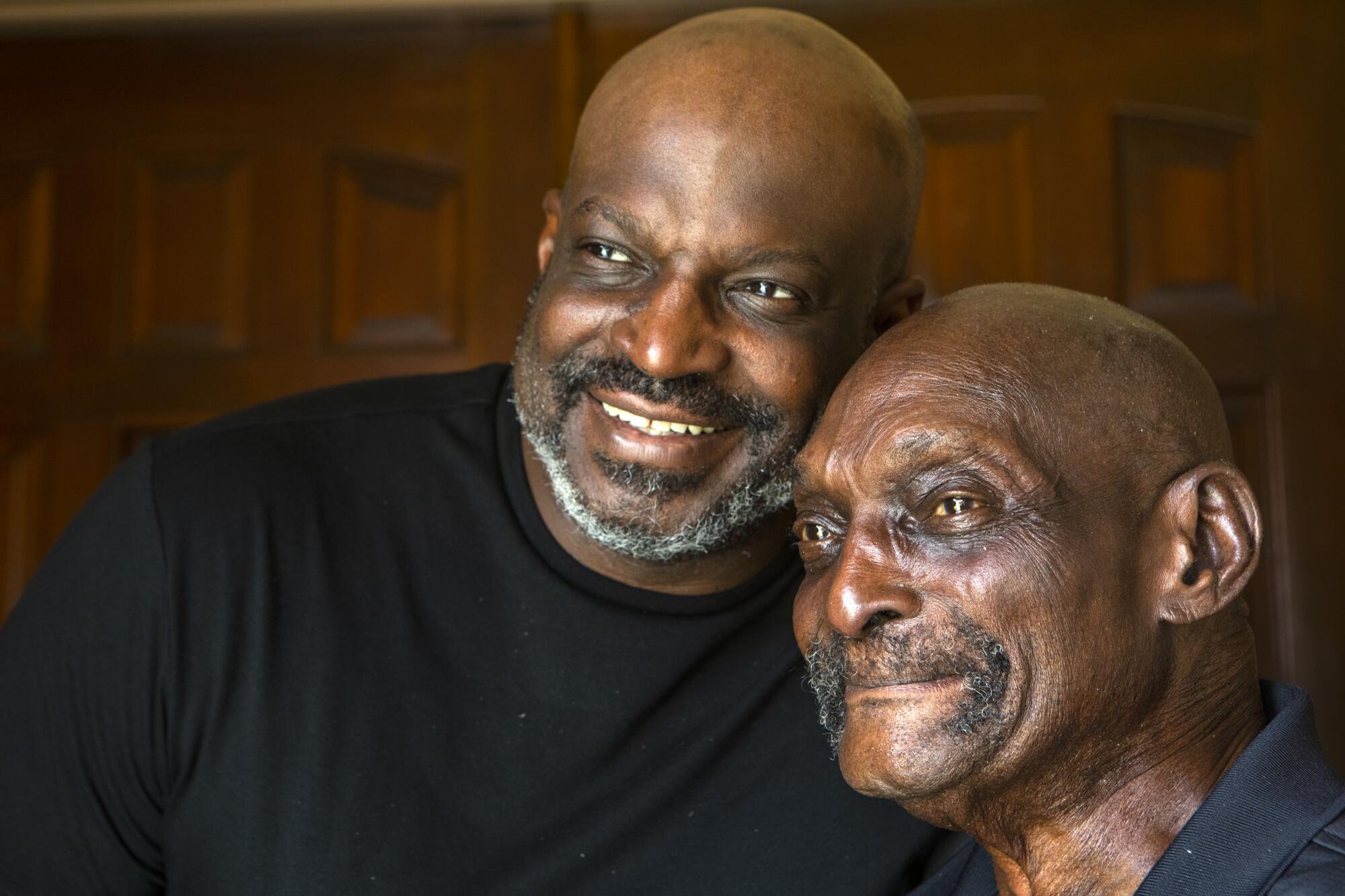
- Share via
I’d seen pictures from back then, lots of times.
Four handsome Black men in flashy suits crooning a song with showbiz flair and joy in their eyes.
But those glossy prints that hung on the walls and lived in our photo albums hadn’t prepared me for what it would be like to see and hear them in action.
A few years ago, my family received a videotape copy of an unaired episode of the 1960s music show “Shindig!” When I was told what was on it, I popped it into my parent’s last remaining VCR and hit fast forward. I was searching for the moment when L.A. radio personality Jimmy O’Neill introduced the next act performing a new dance called “Jamaica Ska” and a song with the same title.
“And now, here to show you how to do it are the great Hollywood All Stars and the Shindig! Dancers!”
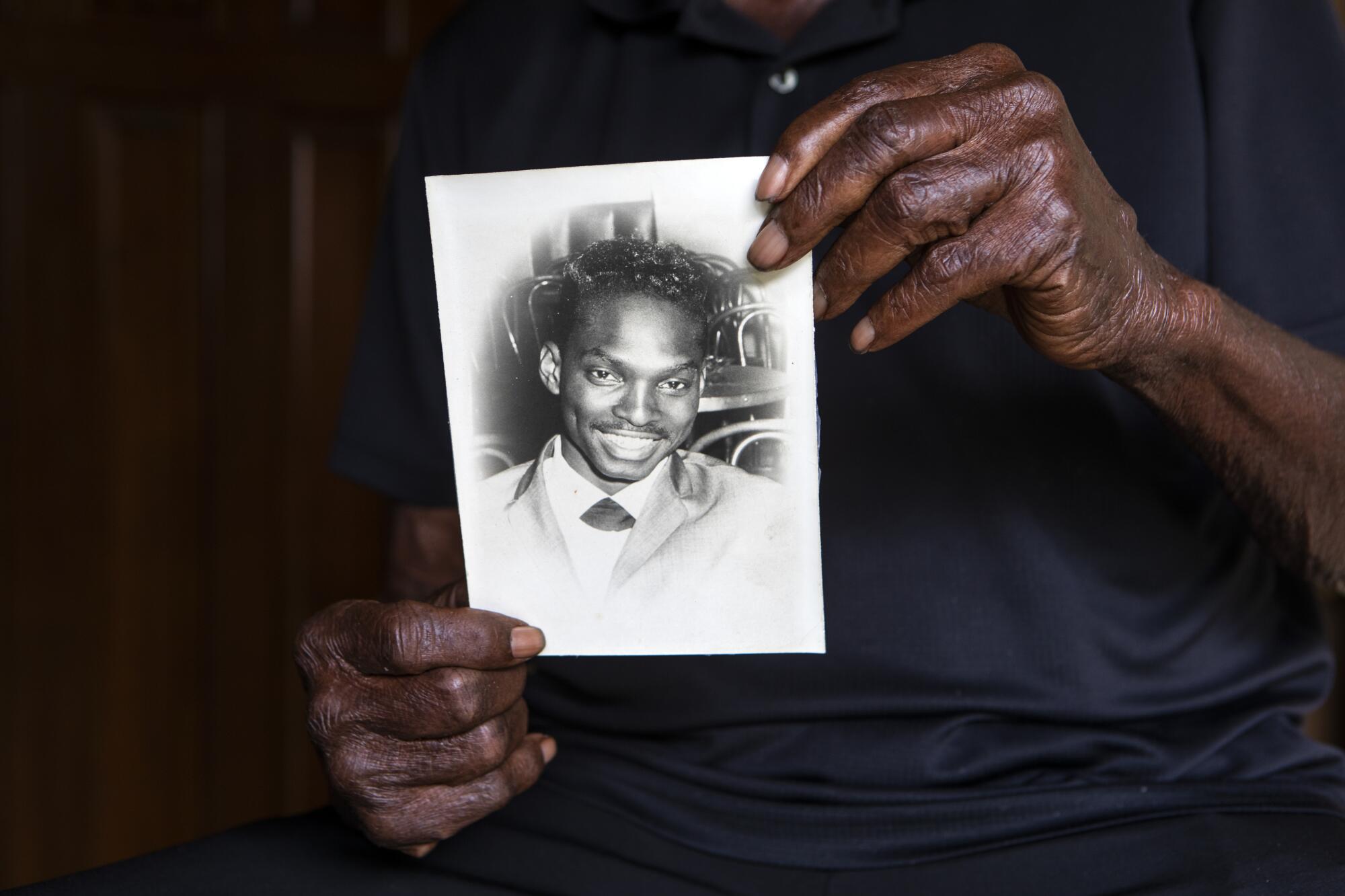
I watched the foursome take the stage, and my eyes immediately locked on this one cool cat singing and dancing his heart out. That guy, center right, was my dad, Robert Meeks Jr. He was 24 years old.
Here he was in this whole other world we’d heard about only through his stories. Here was this other Robert Meeks, circa 1964 — long before I was born — surging to life in grainy black and white.
I rewound the tape and played it again and again while my dad sat on the sofa, beaming the entire time.
The Hollywood All Stars, from left: Reginald Cornell Atkins, Bruce Meeks, Robert Meeks Jr. and Louis Meeks.
This pilot episode, shot months before the series would launch its 16-month run in September 1964, featured the Righteous Brothers and a performance by the unparalleled Little Richard, someone my father said he knew back in the days when our family in Nashville would host Black entertainers.
For years, I’d been told by my dad, rather matter-of-factly, that his singing group had performed on a TV show that never aired. But watching his amazing performance really got my attention — and raised all kinds of questions.
I wanted to document what it must have been like for my father to be a Black entertainer in the ’50s and ’60s, striving to create and perform during a time when America was being called upon to reckon with civil rights.
At the start of 2020, when we started to see a steady rise in COVID-19 cases in the U.S., my father was scheduled to have surgery to repair a nerve that severely limited his mobility. For an 80-year-old man, the timing of going into the hospital and having an extended stay in another facility to recuperate raised concerns for our family.
I was rattled when I thought about how I’d taken our regular Sunday dinners together for granted, that there was still so much I didn’t know about him. I couldn’t stop thinking about the things we rarely talked about and the questions I hadn’t asked.
Fortunately, his surgery went well. I took any afternoon or evening I had free to visit during his recovery. I started to push him for details about his days before I was born. And I came to understand that preserving these stories was an imperative I couldn’t ignore.
Our visits usually started like this:
“How’re you doing?”
“Doing better, Son.”
“That’s great! So hey, can I ask you again about when you did shows in the ‘50s and ‘60s?”
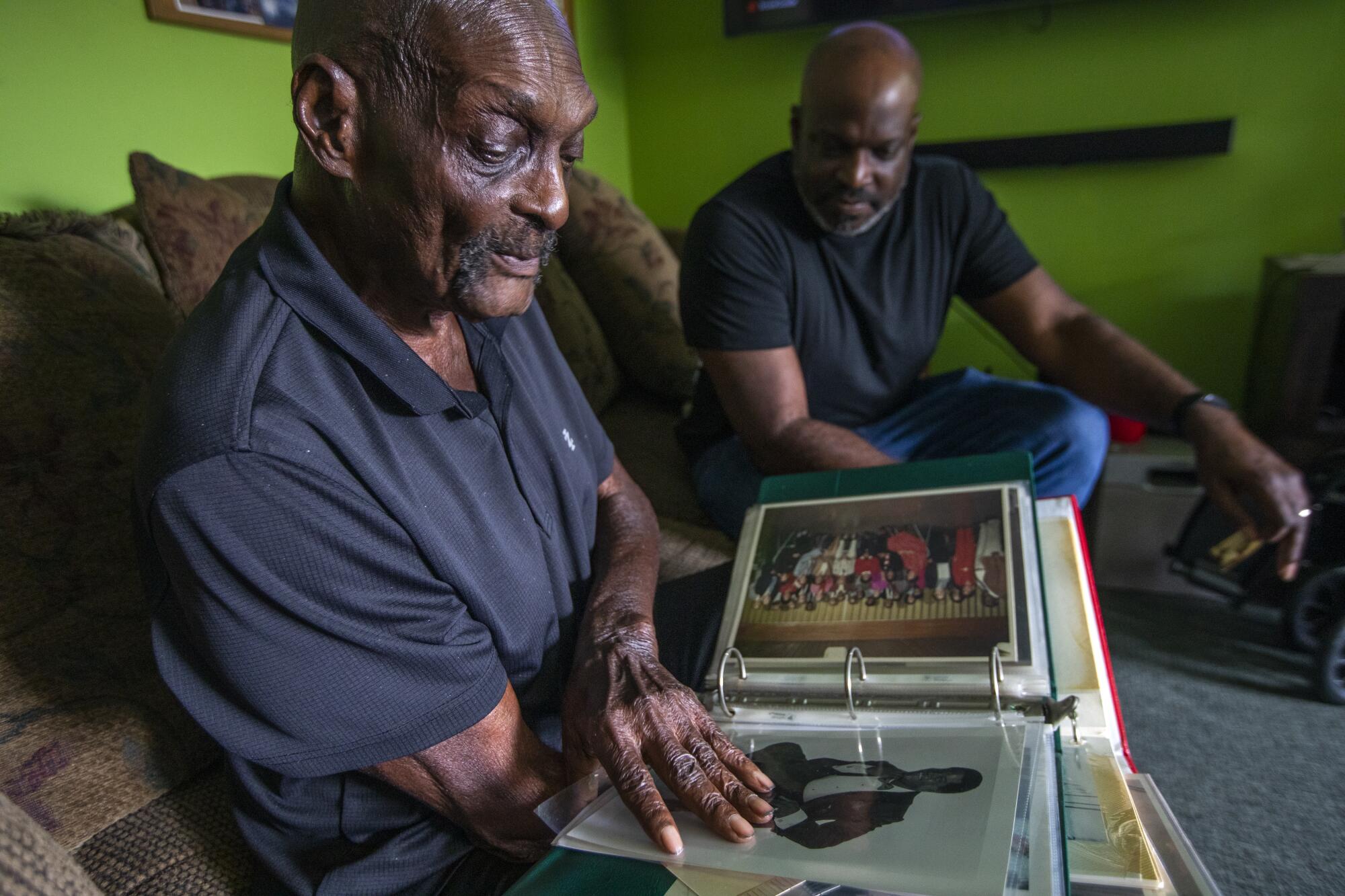
The group that would become the Hollywood All Stars was known by a few other names in its early days in Nashville. For a while, “The Classics” gained traction as the four men performed at a handful of neighboring Black venues in the 1950s.
The group consisted of my uncles Bruce and Louis Meeks; my dad’s best friend, Mr. Reginald Cornell Atkins; and my father, whom they called Sonny but nicknamed “Lead.” (Dad was the lead singer with his brother Bruce, and he was also the oldest of the three boys.) He also had other nicknames like “Brick” due to his, at times, hardheaded uncompromising nature.
As several of my father’s friends from Nashville would attest over the years, the quartet was a draw back then. And that popularity led to shows in places where the audiences were primarily white, including spots in Nashville’s Printers Alley where the group sang covers of songs recorded by big-time musicians such as Fats Domino.
For a time, the Classics continued to play shows on both sides of the tracks, until white fans followed them to the Black clubs. The crossover drew the ire of some locals, and word got back to my grandparents.
“My daddy told us, ‘Don’t you know they’ll burn my damn house down?’ ” Dad said. “And I think it was about six weeks after that I decided we were moving out.”
Fueled by dreams and a need for self-preservation, my father, his brothers and his best friend made their way to California to take on the music industry.
The group settled in L.A. around 1960 and rebranded themselves as the Hollywood All Stars. Between booking local gigs, my uncles shined shoes on Central Avenue while Dad collected rent for the owner of a boardinghouse that catered to fellow performers. He celebrated his 21st birthday in Los Angeles.
Then in 1964, the Hollywood All Stars were presented with a major opportunity to boost their exposure.
British music producer Jack Good, an ardent fan of rock ‘n’ roll, had been given the go-ahead by ABC to create a new take on the music show. He’d planned a prime-time revue with live performances before an audience — a format without the interspersed interviews featured on “American Bandstand” or “The Ed Sullivan Show.”
“Shindig!” would feature multiple acts nonstop for the entire half-hour.
Recently, during one of our family gatherings at my parents’ house, we watched the Hollywood All Stars’ “Shindig!” performance again.
“That’s Robert right there,” my mother said.
“I can’t imagine you moving like this!” said my sister, Nalena, marveling at the performance on-screen. “Look at Mr. Atkins and Louis and Bruce!”
Dad laughed and said, “We brought soul!”
Their performance of Byron Lee and the Dragonaires’ “Jamaica Ska” went down just the way they’d rehearsed it, complete with some dance direction from my Uncle Louis. The Hollywood All Stars and the “Shindig!” dancers gave it their all — moving their shoulders, swinging their arms and bobbing their heads.
“Ska, Ska, Ska. Jamaica Ska! Now everybody can do the Ska. It’s the new dance you can’t resist!”
From left: Reginald Cornell Atkins, Bruce Meeks, Robert Meeks Jr. and Louis Meeks perform “Jamaica Ska” on the 1964 pilot episode of “Shindig!”
Just about everything I’ve read about “Shindig!” emphasized the live performances. Singer and show regular Bobby Sherman once told my colleague David Wharton that “Shindig!” was the forerunner of MTV, a manual of sorts on how to do rock ‘n’ roll on screen.
I sped ahead to see the Righteous Brothers in action. Dad had always mentioned that the Hollywood All Stars would open shows for them. “We performed together a lot of times,” he said. Then it was time to watch the special guest act, Little Richard.
After O’Neill announced, “Ladies and gentleman, the most electrifying entertainer in the world...,” the camera cut to the star, who was already standing and playing piano for an abbreviated version of his latest single, “Bama Lama Bama Loo.” The audience roared in the background as Richard kicked his leg onto the piano — a fan favorite move.
“Well all right! Well all right!” Richard called to the crowd and it promptly yelled back.
When he launched into “Whole Lotta Shakin’ Goin’ On,” it was as if the audience and the background dancers stepped on a live wire. (The same could be said for my family members who screamed “Wooo!” as they watched the legendary singer unleash his signature howl.)
U.K.-based writer Peter Checksfield, who has seen every episode of “Shindig!” and wrote a book about the show, said it would have been Richard’s first U.S. television appearance, adding, “It was unbelievable.”
He played furiously, his face filling the TV screen, and people in the audience danced in the aisles. Little Richard had seized the room.
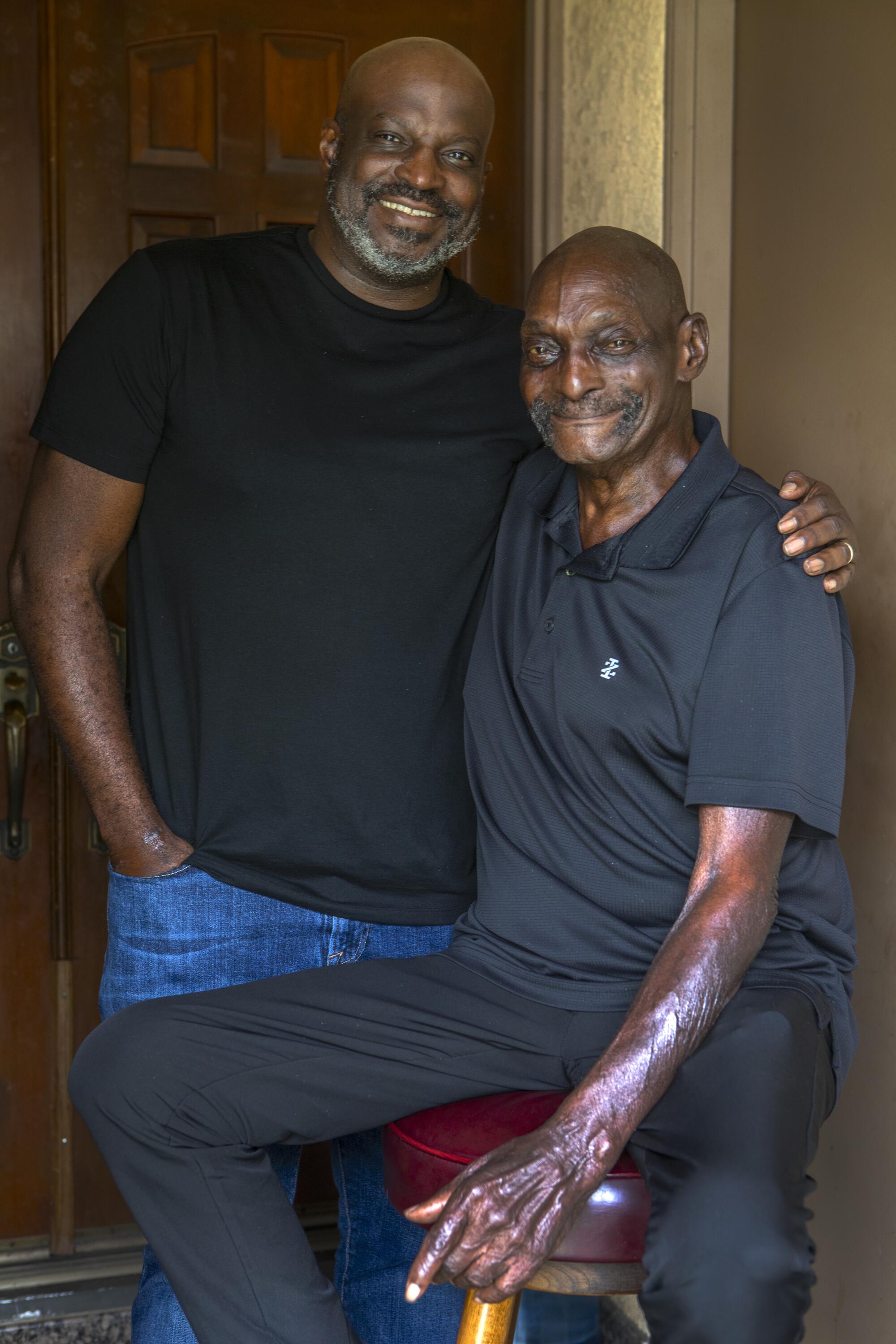
Then it was time for the credits to roll. “Here we come!” Dad announced from the couch, as we watched the dancers, and the other performers, including the Hollywood All Stars, filling the stage.
Ultimately, ABC elected to launch the series with another episode, one headlined by the Everly Brothers and Sam Cooke. Checksfield wrote that television executives wanted something “more suitable for family viewing.”
“You didn’t have nothing like this on no TV,” Dad said. “I’m telling you they weren’t ready for that yet. They weren’t ready for that scene.”
“How did you feel as a Black entertainer with this whole ‘Shindig!’ thing? ” my sister asked.
“I feel like we were breaking through for Blacks,” he said. “That’s the way we felt.”
Some weeks after our family viewed the episode for the second time, I asked my father whether he had any thoughts about what the show would have meant for the Hollywood All Stars and their careers.
He answered without hesitation.
“We were doing an act,” Dad said. “Jack Good said this is what he was after for the show, and we did the job.”
Back then, Dad said, life for entertainers moved fast. The next gig was the next gig, whether it was a series of college fraternity performances or numerous appearances on the Black music circuit at spots like the California Club and Maverick’s Flat. “Shindig!,” as it turned out, was just another gig — but it was a gig that continues to resonate, as my dad made clear.
“That made my day, Son, bringing back some of the old memories.”
“I always thought it was when he had the most fun,” my sister said about Dad’s years as a singer. “And when he could be his most authentic self.”
The Righteous Brothers were virtual regulars on “Shindig!” appearing in more than 20 episodes. The show featured many other big names such as Tina Turner, James Brown, Ray Charles and the Beatles before it ended in 1966, a victim of declining ratings amid competition from shows such as “Hullabaloo,” “Where the Action Is” and “Hollywood a Go-Go.”
The Meeks brothers and Mr. Atkins wound down their music careers — for the most part — in the 1970s, starting families and launching businesses. My Uncle Louis passed away in 1985. My Uncle Bruce, always full of swagger but patient when he was trying to teach me how to tune my guitar, would continue to perform until his passing in 1999. Mr. Atkins, who spent a lot of late nights at my dad’s home bar, laughing and reminiscing, passed away in 2018.
My father, the last Hollywood All Star, continues to work on his golf swing to stay active — and to fulfill his weekly diet of trash talking, promising to kick my ass on the course. Those conversations make him smile — just as he does when he’s talking about his performing days.
I’ve learned to appreciate how lucky I am to have those smiles and those stories.
I’ve learned to remind myself to take whatever I have — pen, paper, iPhone, sound recorder — when I talk to my folks about their lives and not just hear but listen.
I’ve still got a lot of work to do, and I can’t wait.
- Share via
Watch L.A. Times Today at 7 p.m. on Spectrum News 1 on Channel 1 or live stream on the Spectrum News App. Palos Verdes Peninsula and Orange County viewers can watch on Cox Systems on channel 99.
More to Read
Sign up for Essential California
The most important California stories and recommendations in your inbox every morning.
You may occasionally receive promotional content from the Los Angeles Times.
